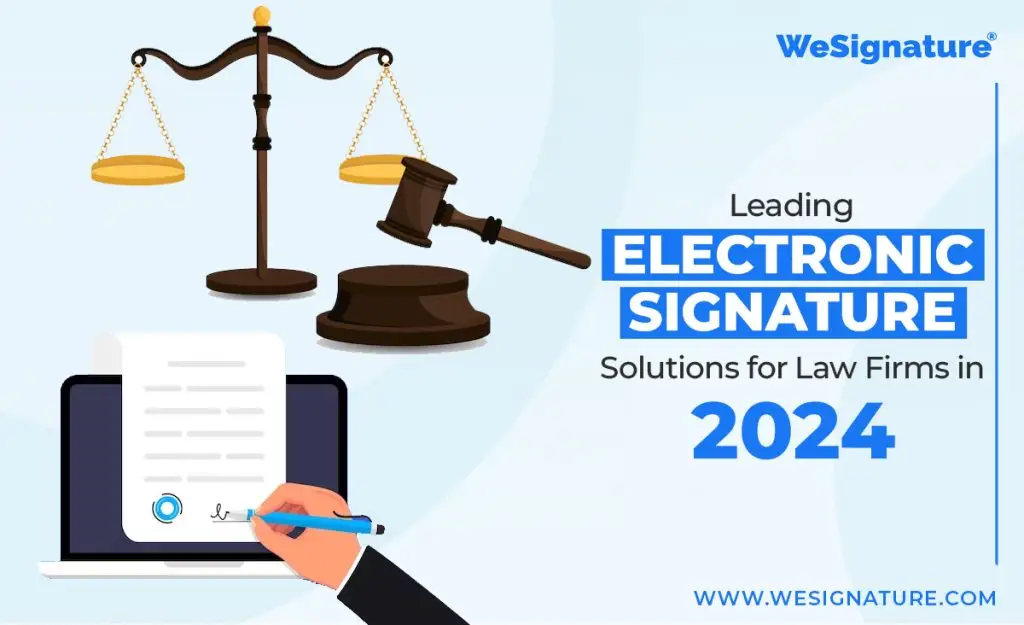Leading Electronic Signature Solutions for Law Firms in 2024

A law firm has to manage a lot of documents every day. Organizing these documents in the traditional way not only increases the workload of employees but also makes the law firm more vulnerable to security breaches. Adopting electronic signature solutions for law firms can streamline document management and enhance security.
Moreover, printing all these documents is expensive and bad for the environment. Also, calling all signers to sign the document is a costly organizational nightmare, and wet signatures make signature forgery even more likely.
Fortunately, electronic signature solutions can solve all these problems. In addition to secure online document storage and organization, signatures are just a few clicks away, protected with multiple security measures to prevent forgery.
Evolution of Electronic Signature Technology
The development of electronic signature technology has significantly changed legal practices. Understanding its historical roots and recent technological advancements provides insight into its current capabilities.
Historical Overview
Electronic signatures emerged in the late 20th century, driven primarily by the advent of the Internet and digital communications. The US government enacted the Electronic Signatures in Global and National Commerce (ESIGN) Act in 2000, which legalized electronic signatures in legal agreements. This law allowed law firms to integrate digital signatures into their practice.
In 2001, the Uniform Electronic Transactions Act (UETA) further streamlined regulations. These legal frameworks established the validity of electronic signatures, making them a safer alternative to traditional handwritten signatures. With growing acceptance, this technology gained momentum in various fields, including law.
Technological Advancements
Recent technological advancements have improved electronic signature solutions to a great extent. Encryption technology now ensures that signed documents are secure and tamper-proof. Advanced authentication methods such as biometric verification and two-factor authentication make the signing process even more secure.
User interface improvements have made electronic signature platforms more intuitive. Cloud-based solutions allow signing and tracking in real-time, which increases efficiency for law firms. Additionally, integration with practice management software provides seamless workflow.
As these technologies evolve, they continue to address security and compliance challenges, making electronic signatures indispensable in modern legal practices.
Benefits of Electronic Signatures Solution for Law Firms
Electronic signatures offer a variety of benefits that are particularly beneficial to law firms. These include enhanced security features, increased operational efficiency, significant cost reduction, and improved legal compliance. Each benefit plays a vital role in modernizing legal practices.
Enhanced Security
Electronic signatures come with advanced security measures that protect sensitive documents. They often use encryption technology to protect data during transmission, ensuring that only authorized parties can access or alter documents.
Many solutions also incorporate biometric authentication, multi-factor identification, and secure audit trails. These features provide law firms with a higher level of security than traditional paper signatures. The result is a significant reduction in the risk of fraud and unauthorized access to critical information.
Increased Efficiency
Electronic signature solutions simplify the signing process, allowing documents to be completed faster. This eliminates the need for physical meetings, mailing papers, or waiting for signatures to be returned.
With automated reminders and notifications, firms can effectively manage client engagements without any unnecessary delays. Furthermore, electronic documents can be easily stored and retrieved, increasing overall workflow efficiency.
Cost Reduction
The shift to electronic signatures reduces many of the operational costs associated with traditional methods. Expenses related to printing, mailing, and document storage can be significantly reduced.
Additionally, electronic signatures enable remote work, allowing employees to access documents from any location, reducing the need for physical office space and resources. This shift supports law firm budget management while maintaining productivity.
Legal Compliance and Validation
Many electronic signature solutions comply with international and regional legal standards, such as the ESIGN Act and UETA in the United States. This compliance ensures that electronic signatures are legally binding and admissible in courts.
In addition, the use of digital signature technology includes mechanisms to verify identity and consent. This aspect enhances the overall integrity of legal documents, providing law firms with peace of mind when complying with regulatory requirements.
Comparative Analysis of Top Solutions
A careful examination of the leading electronic signature solutions reveals significant differences in features, user experience, and integration capabilities. Understanding these factors helps law firms choose the right solution for their needs.
Feature Set Comparison
The feature set of electronic signature solutions for law firms can vary significantly. Key features to consider include:
- Document Management: Ability to create, store, and organize documents efficiently.
- Security Measures: Implementation of encryption, two-factor authentication, and compliance with legal standards like eIDAS or ESIGN.
- Multi-Signature Support: Options for multiple parties to sign documents simultaneously.
Popular solutions like DocuSign and Adobe Sign offer robust features, including custom branding and built-in templates. Meanwhile, lesser-known options may focus on affordability while lacking extensive features. Analyzing these aspects ensures that firms choose a solution that suits their operational needs and enhances productivity.
User Experience
User experience plays a crucial role in the effectiveness of electronic signature solutions. Key considerations include the following:
- User Interface Design: A clear and intuitive interface reduces the learning curve for staff.
- Mobile Accessibility: Solutions that provide mobile applications allow signing on the go, which can increase efficiency.
- Customer Support: Availability of help resources and responsive support can impact overall usability.
Many solutions prioritize user experience, offering features like guided signing processes. Law firms should evaluate user feedback and trial versions to understand which platform is the most comfortable and intuitive for their specific workflow.
Integration Capabilities
Integration capabilities determine how well an electronic signature solution fits into a law firm’s existing software ecosystem. Important factors include:
- Compatibility with Case Management Software: Integration with tools like Clio or PracticePanther can streamline workflows.
- API Accessibility: A well-documented API allows for customization and further integrations as needed.
- Third-Party Integrations: Compatibility with popular tools like Google Workspace and Microsoft 365 can enhance usability.
Many solutions prioritize user experience, offering features like guided signing processes. Law firms should evaluate user feedback and trial versions to understand which platform is the most comfortable and intuitive for their specific workflow.
Implementation Strategies for Law Firms
Effective implementation of electronic signature solutions for law firms requires careful planning and execution. The process should focus on assessing needs, training employees, and transferring data seamlessly.
Needs Assessment
The first step in implementing electronic signature solutions is to conduct a thorough needs assessment. This includes identifying specific requirements related to client interactions, document types, and compliance obligations.
Key considerations include:
- Client Demographics: Understanding the technological readiness of clients can shape the choice of software.
- Legal Focus: Different practice areas may require unique features, such as witness signing for estate planning.
Allocating sufficient time for discussions with stakeholders ensures alignment on objectives and operational needs, paving the way for a successful rollout.
Staff Training and Onboarding
Once needs have been identified, comprehensive training and onboarding is a must. This ensures that all employees are proficient in using the new electronic signature system effectively.
Key training components include:
- Hands-on workshops: Hands-on sessions can help employees become familiar with the software interface and features.
- Resource availability: Providing manuals and quick-reference guides can help users navigate the system.
Incorporating feedback mechanisms during the training phase creates an environment for continuous improvement, allowing adjustments to be made as needed based on employee input.
Data Migration
Migrating existing data to the new electronic signature platform requires meticulous planning. This step influences the integrity and accessibility of documents post-implementation.
Important steps in data migration include:
- Data Mapping: Identifying what data needs to be transferred and where it will reside within the new system.
- Testing: Running pilot migrations to identify any issues before full-scale implementation is critical.
Ensuring all compliance requirements are met during this phase helps mitigate risks associated with data handling, maintaining the firm’s reputation for security and confidentiality.
Security and Compliance Considerations
Law firms must prioritize security and compliance when adopting electronic signature solutions. Ensuring compliance with legal standards and the protection of client data is critical to maintaining trust and integrity in legal practices.
Understanding E-Signature Laws
Electronic signatures are governed by various laws, such as the E-Sign Act and UETA in the United States. These laws establish that electronic signatures have the same legal significance as traditional handwritten signatures.
It is important for law firms to know which documents can be signed electronically and any specific requirements for certain types of agreements. For example, some documents, such as wills and property deeds, may have additional state-specific regulations.
Firms should also be aware of international regulations. The European Union’s eIDAS regulation outlines specific standards for e-signatures within member states, which affects firms handling cross-border transactions.
Data Privacy and Protection
Data privacy is paramount in the legal sector. Firms must ensure that the electronic signature solution they choose complies with regulations such as GDPR and CCPA.
These regulations require strict data handling practices. Law firms must implement measures to protect personal information during the signing process. This includes encryption, secure storage, and controlled access to sensitive data.
Providers should also offer features such as audit trails and tamper-proofing to enhance security. These features help establish accountability and traceability, allowing firms to track any changes made to signed documents.
Risk Management
Effective risk management strategies are essential when integrating e-signature solutions. Firms should thoroughly evaluate the potential vulnerabilities associated with electronic signatures.
Identifying risks involves evaluating the technology used, employee training, and client interactions. Firms should ensure that all employees are educated on the best ways to safely use electronic signatures.
Regular security audits and vulnerability assessments are important. These help identify vulnerabilities in the electronic signature process, allowing firms to proactively address issues. It is also important to implement incident response plans, allowing firms to act quickly in the case of a data breach or security incident.
Client Experience and Relationship Management
Effective client experience and relationship management are crucial for law firms using electronic signature solutions. These components ensure that clients feel valued and secure during their interactions while establishing trust that enhances long-term relationships.
Client Onboarding
Client onboarding involves familiarizing new clients with the electronic signature online process. A streamlined onboarding experience helps in setting the tone for the overall relationship.
- User-Friendly Interfaces: Solutions must provide intuitive interfaces, enabling clients to easily navigate the signing process.
- Educational Resources: Firms can enhance onboarding through tutorials, FAQs, and support articles that explain features and functionalities.
- Personalized Communication: Tailoring communication during onboarding creates a welcoming atmosphere, encouraging clients to engage.
This approach helps clients feel more comfortable and confident while interacting with the law firm.
Maintaining Trust and Security
Trust is foundational in client relationships, especially regarding sensitive documents. Implementing robust security measures promotes confidence in the electronic signature solution for law firms.
- Data Encryption: Utilizing industry-standard encryption protects client information during transmission and storage.
- Authentication Methods: Multi-factor authentication adds an additional layer of security, verifying the identity of signers.
- Compliance with Regulations: Adhering to legal standards, like eIDAS and ESIGN, reassures clients that the firm prioritizes their protection.
This focus on security strengthens the client-law firm relationship by minimizing risks and enhancing confidence.
Support and Accessibility
Offering accessible support enhances client satisfaction and loyalty. Law firms should ensure that clients can easily access assistance when needed.
- 24/7 Customer Support: Providing round-the-clock support via chat, phone, or email addresses client concerns immediately.
- Accessible Documentation: Clear and concise guides should be available to help clients navigate the electronic signature system.
- Feedback Mechanisms: Actively soliciting and incorporating client feedback into the process helps law firms adapt to client needs.
These practices foster a responsive environment that can significantly improve the overall client experience.
Future Trends in Digital Signature Technology
As digital signature technology evolves, two important trends emerge: the use of predictive analytics and the incorporation of blockchain. These advancements promise to increase security, streamline processes, and improve the user experience for law firms.
Predictive Analytics
Predictive analytics will play a key role in improving digital signature solutions. By leveraging historical data and machine learning algorithms, platforms can anticipate user behavior and identify trends in document processing.
This capability can lead to improved efficiency, as law firms can receive alerts about potential bottlenecks or compliance risks. Advanced analytics can also streamline workflows, ensuring that pending signatures are acted upon in a timely manner. The ability to anticipate needs enables better resource allocation and promotes proactive decision-making.
Blockchain Integration
Blockchain technology offers significant potential for digital signatures, particularly with regard to security and authenticity. By creating a tamper-proof record of signed documents, blockchain ensures that each transaction is immutable and verifiable.
This decentralized approach increases trust between parties, as stakeholders can independently verify the integrity of documents. Additionally, smart contracts can automate execution processes following the verification of signatures, reducing delays. Electronic signature solutions for law firms can benefit from reduced costs and reduced fraud risk through these secure, transparent transactions.
Conclusion
Investing in the correct e-signature technology eliminates the burden of document preparation and sharing (which is significant for law firms!) while also ensuring the security of all contracts and agreements.
During your evaluation process, verify that the software can prevent data leaks and provide a seamless experience to your customers. It should be a platform that fits your goals and budget and is easy for your team and clients to understand.



